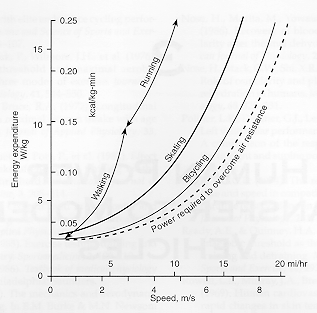Energy expenditure in various types of motion is illustrated in the diagram below. It is seen that the bicycle represents a significant advantage in terms of energy use as compared to walking, running or skating. In all cases the energy requirement increases
non-linearly with the
increase in velocity. The curve showing the power required to overcome drag
due to the air suggests that very little work is lost in the mechanical components
of the bicycle. At 7 m/s, 86% of the energy expended by a cyclist is
used to overcome the air resistance. For a skater at the same speed, air resistance
only accounts for about 57% of the total energy used.
Under
steady state conditions, the energy use should correspond to energy production
by the body, and this depends upon the rate of oxygen consumption by the body.
For short sprints, stored oxygen may augment oxygen uptake in energy production.

From: Abbott & Wilson,
"Human-Powered Vehicles,"
Human Kinetics (1995)
| Human Power |
| Prev |
| Next |